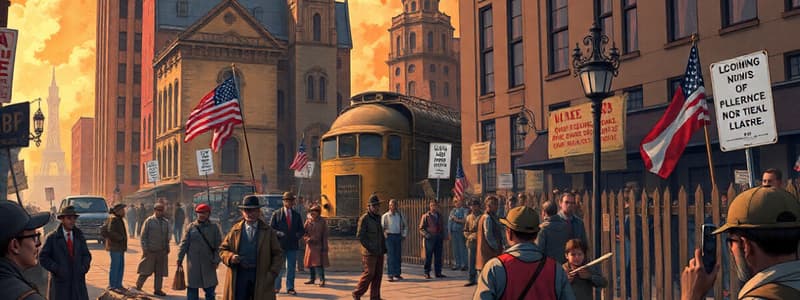Podcast
Questions and Answers
Which of the following was NOT a factor contributing to the rise of Nativism in the late 19th century?
Which of the following was NOT a factor contributing to the rise of Nativism in the late 19th century?
- The widespread support of labor unions for new immigrants (correct)
- Fear of economic competition from new immigrants
- The belief that new immigrants were unable to assimilate into American culture
- Religious differences between new immigrants and existing Americans
What was the primary goal of the Grange movement?
What was the primary goal of the Grange movement?
- To secure voting rights for women
- To establish free public education
- To promote the interests of factory workers
- To regulate railroad monopolies (correct)
Which of the following is an accurate description of the impact of the Triangle Shirtwaist Factory fire?
Which of the following is an accurate description of the impact of the Triangle Shirtwaist Factory fire?
- It inspired the formation of powerful labor unions that successfully negotiated for better factory working conditions.
- It had little impact on public awareness of workplace safety issues.
- It highlighted the dangers of unsafe working conditions in factories and helped fuel the movement for reform. (correct)
- It led to the immediate passage of federal legislation regulating factory safety.
What was the main goal of the Populist Party?
What was the main goal of the Populist Party?
Which of the following is an example of a political machine during the Gilded Age?
Which of the following is an example of a political machine during the Gilded Age?
What was a key difference between the American Federation of Labor (AFL) and the Knights of Labor (KOL)?
What was a key difference between the American Federation of Labor (AFL) and the Knights of Labor (KOL)?
Which of the following events was a major setback for the labor union movement in the late 19th century?
Which of the following events was a major setback for the labor union movement in the late 19th century?
What was the main cause of the rapid urbanization in the late 19th century?
What was the main cause of the rapid urbanization in the late 19th century?
What was the main argument for bimetallism in the late 19th century?
What was the main argument for bimetallism in the late 19th century?
Which of the following was a major concern for immigrants arriving in the United States during the late 19th century?
Which of the following was a major concern for immigrants arriving in the United States during the late 19th century?
What was a major contributing factor to the rise of labor unions during the Gilded Age?
What was a major contributing factor to the rise of labor unions during the Gilded Age?
Which of the following individuals is NOT associated with labor movements during the Gilded Age?
Which of the following individuals is NOT associated with labor movements during the Gilded Age?
The term "gilded" in the context of the Gilded Age refers to:
The term "gilded" in the context of the Gilded Age refers to:
What was a key difference between the Grange movement and the Populist Party?
What was a key difference between the Grange movement and the Populist Party?
What was a major concern for farmers during the Gilded Age?
What was a major concern for farmers during the Gilded Age?
Which of the following Supreme Court cases was NOT related to the issue of immigration during the Gilded Age?
Which of the following Supreme Court cases was NOT related to the issue of immigration during the Gilded Age?
What was the main goal of the Sherman Anti-Trust Act?
What was the main goal of the Sherman Anti-Trust Act?
What was a common tactic used by big businesses against labor unions during the Gilded Age?
What was a common tactic used by big businesses against labor unions during the Gilded Age?
What was a key effect of the completion of the Transcontinental Railroad?
What was a key effect of the completion of the Transcontinental Railroad?
What was the Homestead Act of 1862 and what were its effects?
What was the Homestead Act of 1862 and what were its effects?
What was a significant consequence of the westward expansion and its impact on Native American populations?
What was a significant consequence of the westward expansion and its impact on Native American populations?
Which of the following was NOT a major factor contributing to the Western Indian Wars?
Which of the following was NOT a major factor contributing to the Western Indian Wars?
Which of these events IS NOT an example of the violent clashes between settlers and Native Americans during the Western Indian Wars?
Which of these events IS NOT an example of the violent clashes between settlers and Native Americans during the Western Indian Wars?
Which of the following was a key technological innovation of the 2nd Industrial Revolution?
Which of the following was a key technological innovation of the 2nd Industrial Revolution?
How did the growth of big business affect the economy and society during the 2nd Industrial Revolution?
How did the growth of big business affect the economy and society during the 2nd Industrial Revolution?
Which of the following business innovations emerged during the 2nd Industrial Revolution?
Which of the following business innovations emerged during the 2nd Industrial Revolution?
Which of the following figures is NOT associated with the rise of big business during the 2nd Industrial Revolution?
Which of the following figures is NOT associated with the rise of big business during the 2nd Industrial Revolution?
Which of the following was NOT a consequence of the 2nd Industrial Revolution?
Which of the following was NOT a consequence of the 2nd Industrial Revolution?
What was the main idea behind the policy of laissez-faire?
What was the main idea behind the policy of laissez-faire?
What did Social Darwinism argue?
What did Social Darwinism argue?
Which of the following was a major factor driving immigration to the United States during the 2nd Industrial Revolution?
Which of the following was a major factor driving immigration to the United States during the 2nd Industrial Revolution?
How did the limited regulation of big businesses during the 2nd Industrial Revolution affect American society?
How did the limited regulation of big businesses during the 2nd Industrial Revolution affect American society?
What was the main criticism of the 'Robber Barons'?
What was the main criticism of the 'Robber Barons'?
How did the growth of the Sears catalog impact the 2nd Industrial Revolution?
How did the growth of the Sears catalog impact the 2nd Industrial Revolution?
Which of the following best describes the goal of Southern 'Redeemers' in the post-Reconstruction period?
Which of the following best describes the goal of Southern 'Redeemers' in the post-Reconstruction period?
What was the significance of the Compromise of 1877 in terms of Reconstruction?
What was the significance of the Compromise of 1877 in terms of Reconstruction?
The 13th Amendment abolished slavery in the United States. Which amendment further protected the rights of newly freed slaves by defining citizenship and granting equal protection under the law?
The 13th Amendment abolished slavery in the United States. Which amendment further protected the rights of newly freed slaves by defining citizenship and granting equal protection under the law?
What key factor led to the rise of the Radical Republicans in Congress during Reconstruction?
What key factor led to the rise of the Radical Republicans in Congress during Reconstruction?
Which of the following best describes the impact of the Jim Crow system on African Americans in the South?
Which of the following best describes the impact of the Jim Crow system on African Americans in the South?
What was the significance of the Plessy v. Ferguson Supreme Court decision?
What was the significance of the Plessy v. Ferguson Supreme Court decision?
The 15th Amendment guaranteed suffrage regardless of race. What was one of the limitations of this amendment?
The 15th Amendment guaranteed suffrage regardless of race. What was one of the limitations of this amendment?
What was the Freedmen's Bureau, and what was its role during Reconstruction?
What was the Freedmen's Bureau, and what was its role during Reconstruction?
What were 'Black Codes', and how did they affect freedmen and women in the South?
What were 'Black Codes', and how did they affect freedmen and women in the South?
How did the 'sharecropping' system impact freedmen and women in the South during the post-Reconstruction period?
How did the 'sharecropping' system impact freedmen and women in the South during the post-Reconstruction period?
Which of the following best describes the impact of the Ku Klux Klan (KKK) on Southern society during the Reconstruction period?
Which of the following best describes the impact of the Ku Klux Klan (KKK) on Southern society during the Reconstruction period?
How did the transcontinental railroad contribute to the westward expansion of the United States?
How did the transcontinental railroad contribute to the westward expansion of the United States?
Which of the following best defines the concept of 'Manifest Destiny' as it relates to the westward expansion of the United States?
Which of the following best defines the concept of 'Manifest Destiny' as it relates to the westward expansion of the United States?
What was the significance of Lincoln's assassination in relation to Reconstruction?
What was the significance of Lincoln's assassination in relation to Reconstruction?
Which law guaranteed voting rights for African American men, although it faced limitations in its enforcement?
Which law guaranteed voting rights for African American men, although it faced limitations in its enforcement?
What was the primary difference between President Lincoln's plan for Reconstruction and President Johnson's plan?
What was the primary difference between President Lincoln's plan for Reconstruction and President Johnson's plan?
Flashcards
The Era of Good Stealings
The Era of Good Stealings
A period marked by widespread corruption and graft in urban politics.
William Tweed
William Tweed
A key political boss known for his role in corrupt activities in New York City.
Labor Unions
Labor Unions
Organizations that emerged to advocate for better working conditions and rights for workers.
Triangle Shirtwaist Fire
Triangle Shirtwaist Fire
Signup and view all the flashcards
Populism
Populism
Signup and view all the flashcards
Panic of 1893
Panic of 1893
Signup and view all the flashcards
Sherman Anti-Trust Act
Sherman Anti-Trust Act
Signup and view all the flashcards
Bimetallism
Bimetallism
Signup and view all the flashcards
Nativism
Nativism
Signup and view all the flashcards
Old vs. New Immigration
Old vs. New Immigration
Signup and view all the flashcards
Political Machines
Political Machines
Signup and view all the flashcards
The Gilded Age
The Gilded Age
Signup and view all the flashcards
Chinese Exclusion Act
Chinese Exclusion Act
Signup and view all the flashcards
Skyscrapers
Skyscrapers
Signup and view all the flashcards
Gentlemen's Agreement
Gentlemen's Agreement
Signup and view all the flashcards
Transcontinental Railroad
Transcontinental Railroad
Signup and view all the flashcards
Homestead Act
Homestead Act
Signup and view all the flashcards
Bessemer Process
Bessemer Process
Signup and view all the flashcards
Social Darwinism
Social Darwinism
Signup and view all the flashcards
Western Indian Wars
Western Indian Wars
Signup and view all the flashcards
Robber Barons
Robber Barons
Signup and view all the flashcards
Captains of Industry
Captains of Industry
Signup and view all the flashcards
Electric Generator
Electric Generator
Signup and view all the flashcards
Telegraph
Telegraph
Signup and view all the flashcards
Immigration and Labor Demand
Immigration and Labor Demand
Signup and view all the flashcards
Natural Resources
Natural Resources
Signup and view all the flashcards
Elevator
Elevator
Signup and view all the flashcards
Second Industrial Revolution
Second Industrial Revolution
Signup and view all the flashcards
Reconstruction
Reconstruction
Signup and view all the flashcards
13th Amendment
13th Amendment
Signup and view all the flashcards
Black Codes
Black Codes
Signup and view all the flashcards
Radical Republicans
Radical Republicans
Signup and view all the flashcards
14th Amendment
14th Amendment
Signup and view all the flashcards
15th Amendment
15th Amendment
Signup and view all the flashcards
Freedmen's Bureau
Freedmen's Bureau
Signup and view all the flashcards
Redemption
Redemption
Signup and view all the flashcards
Compromise of 1877
Compromise of 1877
Signup and view all the flashcards
Jim Crow Laws
Jim Crow Laws
Signup and view all the flashcards
Sharecropping
Sharecropping
Signup and view all the flashcards
KKK (Ku Klux Klan)
KKK (Ku Klux Klan)
Signup and view all the flashcards
Plessy v. Ferguson
Plessy v. Ferguson
Signup and view all the flashcards
Civil Rights Act of 1866
Civil Rights Act of 1866
Signup and view all the flashcards
Military Reconstruction Act of 1867
Military Reconstruction Act of 1867
Signup and view all the flashcards
Study Notes
Labor
- Increased demand for labor due to the 2nd Industrial Revolution created a major wave of immigration
- Old Immigration (1830-1880) came primarily from Western Europe (Ireland and Germany)
- New Immigration (1880-1920) came primarily from Southern and Eastern Europe (Italy, Poland, Hungary), Russia
- 1st wave of Asian Immigration (Chinese 1860s-1880s) and later Japanese immigrants (1880-1908)
- Immigration through Ellis Island in NY and Angel Island in San Francisco led to increased labor for factories, an increase in urbanization
- Nativism
- Old immigrants saw nativism in the form of the American Know Nothing Party of the 1850s
- By the late 1800s, both political parties had nativist elements to their party and endorsed forms of anti-immigrant policies
- Asian immigrants were attacked for various differences - Historian Mae Ngai argues that most Americans saw Asian immigrants as unable to assimilate into American culture
- 1908 and the Ozawa case, like the Chinese Exclusion act of 1882 and the Gentlemen's Agreement of 1908.
Urbanization
- Cities grew rapidly in the late 1800s.
- New Technology like steel allowed cities to expand vertically with skyscrapers and horizontal expansion with bridges.
- New urban culture emerged with leisure activities, street cars (trolleys), and shopping in department stores.
- However, there were also poor living conditions in the form of tenements, disease, vice, and crime.
- Poor working conditions in urban factories (best seen with the Triangle Shirtwaist Factory)
- Finally, political machines developed that controlled city government with the spoils system, voter fraud, and graft. Common. Boss Tweed's political machine in the time period.
Reform Efforts
- Labor Unions were formed as a way to address the poor working conditions, long hours, and low pay. The leading labor unions of the period were the AFL (skilled workers only) and the Knights of Labor (skilled and unskilled together).
- Big business used harsh tactics to prevent success as seen in the Carnegie Homestead Strike of 1892, Big business used various tactics to undermine and weaken labor unions
- The government tended to support big business in labor disputes as seen in the Great Railway Strike of 1877 and the Pullman Strike of 1894 where the US Army broke up the strikes.
- Farmers also faced issues on the Great Plains
- Farmers also faced issues on the Great Plains and sought reform. The Grange movement was an effort to influence the government to regulate railroad monopolies.
- The Grange movement had weakened as the ICC was weakened to the point of being ineffective in regulating monopolies
- Out of the Grange came the Populist political party that sought to regulate railroad monopolies and enact inflationary bimetallism policies to replace the Gold Standard. The Populists supported William Jennings Bryan in the 1896 and 1900 elections, but he lost both elections to McKinley who supported a more pro-business and gold standard approach.
Overall
- The Gilded Age The term "gilded" refers to the gold leaf that was applied to the surface of objects to make them appear more valuable, and it is used to suggest that this period was characterized by a thin veneer of prosperity covering up a more complex reality. During this period, the U.S. economy underwent rapid industrialization, urbanization, and territorial expansion, and the country became a leading industrial power. However, the Gilded Age was also marked by widespread poverty, inequality, nativism, racism as well as corruption in government and business.
Studying That Suits You
Use AI to generate personalized quizzes and flashcards to suit your learning preferences.




